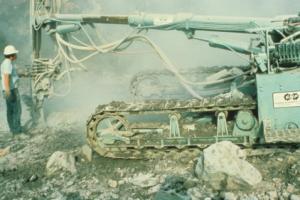
|
|
|
David Weissman, M.D., and Paul Schulte, Ph.D. begin their latest article on the National Institute for Occupational Safety and Health (NIOSH) Science blog with a quote dating back almost four centuries:
"…the dust which is stirred and beaten up by digging penetrates into the windpipe and lungs and produces difficulty in breathing." (Agricola, 1556)
Weissman and Schulte then go on to review the history of crystalline silica as an occupational hazard and to bring us up to date on what -- to the frustration of both scientists and safety professionals -- remains a hazard.
"People only get silicosis from inhaling respirable crystalline silica dust into their lungs," they write. "Thus, every case represents failure to prevent excessive exposure."
With chronic inhallation of silicon dioxide, silicosis can take decades to develop. Higher levels of exposure can bring on the disease more quickly.
With chronic inhallation of silicon dioxide, silicosis can take decades to develop. Higher levels of exposure can bring on the disease more quickly.
Silicosis, which can in its most severe forms be disabling or even fatal, is not the only disease associated with breathing silica. Tuberculosis, lung cancer, and chronic obstructive pulmonary disease (COPD) have been linked to it, and there are indications that it might also cause some autoimmune diseases and chronic renal (kidney) disease.
Weissman and Schulte do an excellent job of explaining where sillica comes from and what kinds of occupational practices cause it to be released into the area, where it can be inhaled by workers.
What is particularly sobering in their post is the discussion of probable underreporting of silicosis cases in the U.S., due to both a lack of effective surveillance data and to the sometimes significant lag time between exposure and disease diagnosis. "Silicosis often presents long after workers have left causative jobs," the authors write. "Such cases may not be detected in Bureau of Labor statistics as occupational disease and will not be detected if disease presents after retirement." Even so, the available does indicate that from 2000-2005, an average of 162 people died annually in the U.S. from or with siliosis.
A 2002 NIOSH review found "a significant risk of chronic silicosis for workers exposed to respirable crystalline silica over a working lifetime" at current OSHA and MSHA PELs and at the NIOSH recommended exposure limit (REL). It recommended: "Until improved sampling and analytical methods are developed for respirable crystalline silica, NIOSH will continue to recommend an exposure limit of 0.05 mg/m3 as a time-weighted average (TWA) for up to a 10-hr workday during a 40-hr workweek. NIOSH also recommends substituting less hazardous materials for crystalline silica when feasible, using appropriate respiratory protection when source controls cannot keep exposures below the REL, and making medical examinations available to exposed workers."
Dr. Weissman is Director of the NIOSH Division of Respiratory Disease Studies.
Dr. Schulte is Director of the NIOSH Education and Information Division.
To read the complete article on the CDC-NIOSH Science blog, click here.


